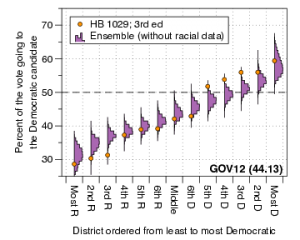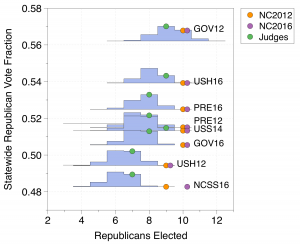[Note: there is a known bug between WordPress and Safari; if the videos below do not render on Safari try switching to a different browser]
In our analysis of the 2017 North Carolina General Assembly redistricting plan, one of our central findings was that the NC Legislature’s 2017 Redistricting Plan implement a firewall protecting Republican majorities and supermajorities.
In trial, for the House districts, we showed animated bar-graphs that demonstrated how the range of democratic seat counts shifted with the statewide fraction of Democratic votes, under various shifts to historical elections. For example, under the United States Senate vote in 2016, the enacted plan elects a typical number of democrats when compared to the ensemble when the statewide Democratic vote fraction is below 49%. As the Democratic vote fraction rises to roughly 50.5% to over 52%, nearly all plans in the ensemble break the Republican supermajority, but the enacted plan remains stuck electing fewer than 48 Democrats to the state House. As the Democratic vote fraction continues to rise, the enacted plan consistently elects fewer Democrats than the ensemble; at a Democratic vote fraction of 54.5%, nearly all plans in the ensemble predict a Democratic majority in the House, yet the ensemble retains a Republican majority. The Republicans retain their majority in the enacted plan even when the Democratic vote fraction surpasses 55%; plans in the ensemble yield a strong majority to the democrats at this point.
The story is NOT about proportional representation, rather about how the #ncga 2017 maps (represented by arrow) systematically under-elect Democrats to a shocking degree.
The story is similar when using vote counts from the 2012 presidential race. Notice, in both videos, as the Democratic vote fraction rises to break the Republican supermajority in the ensemble, the enacted plan dramatically remains to the left of the majority/supermajority line.
And as we examine more elections, the story still remains the same. With Commissioner of Insurance votes from 2012, notice how Democrats are systematically under-elected by the #ncga 2017 Redistricting Plan when compared to our ensemble of thousands and thousands of non-partisan maps
Now with 2008 United States Senate votes. Getting worried about our democracy yet? Across many different vote patterns, same exceptionally atypical under-electing of Democrats persists. The effect is very robust across different offices, across different years.
Same story, now using votes from 2012 Governor election. Each election has a different spatial vote pattern, yet story persists. 2017 #ncga map under-elects Dems when they would typically gain more power. Notice map keeps a Republican majority even when some maps give Democrats a supermajority.
Finally, using 2016 Lt. Governor votes. Again same story. The ensemble accounts for natural packing and the voting geography of North Carolina. But natural packing is not enough to explain the enacted plan’s extreme Republican bias. By comparing the enacted plan to the ensemble of non partisan maps, we separate the effects of natural packing from partisan gerrymandering.
Although the above maps will be remedied by the decision of Lewis v. Common Cause, many states are still highly vulnerable to the effects and consequences of partisan gerrymandering with no hope for remedy from the federal courts. Map makers have inserted themselves in the electoral process and suppressed the Will of the People. If you are worried about the state of our democracy, you should be.
Jonathan Mattingly
Gregory Herschlag








